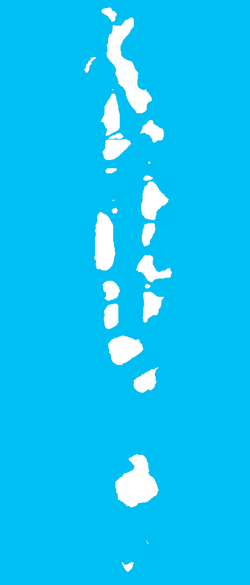Vaadhoo (Gaafu Dhaalu Atoll)
| Vaadhoo | |
|---|---|
| Inhabited island | |
 Vaadhoo Location in Maldives | |
| Coordinates: 00°13′45″N 73°16′30″E / 0.22917°N 73.27500°ECoordinates: 00°13′45″N 73°16′30″E / 0.22917°N 73.27500°E | |
| Country | Maldives |
| Geographic atoll | Upper south Province |
| Administrative atoll | Gaafu Dhaalu Atoll |
| Distance to Malé | 438 km (272 mi) |
| Government | |
| • Island Chief | Mr. Mohamed Abdulla |
| Area | |
| • Total | 1.673 km2 (0.646 sq mi) |
| Dimensions | |
| • Length | 2.320 km (1.442 mi) |
| • Width | 1.130 km (0.702 mi) |
| Population (2011) | |
| • Total | 1,562 |
| • Density | 930/km2 (2,400/sq mi) |
| Time zone | MST (UTC+05:00) |
Vaadhoo (Div: ވާދޫ) is one of the inhabited islands of Southern Huvadhu Atoll, in the Gaafu Dhaalu Atoll administrative division.
Archaeology
Important Buddhist remains have been found on this island, including:
- A ruined stupa called “Vādū Havitta” is located on the north-east of the centre of the island. It is about 90 m in circumference and 10 m in height.
- On the north-east of the centre of the island is another mound which is about 40 m in circumference and 5 m in height.
Thor Heyerdahl visited this island and investigated the ancient Buddhist ruins in the 1980s accompanied by Mohamed Lutfi. Some carved coral stones representing Buddha's foot (Buddhapada) include Vajrayana symbols that were found. However, the ruins have not been well researched yet.
Vaadhoo Farmers Cooperative Society
Vaadhoo Farmers Cooperative Society was established at 21 July 2011. The main object of cooperative society is to overcome the issues faced by farmers in the time of production till the time of market the product. And also help farmers to produce healthy quality products and buy those products and sell to resort markets. Therefore the end result is to increase income level of those who made their live-hoods from agriculture.
Purpose :To increase income level of cooperative members on a sustainable basis by enhancing the value of our products and services
Vision: “To Create a Stable Working Environment for Local Farmers”
Mission: “To improve the administrative and operational level of the cooperative society to meet with the needs and demands of its members through innovative and technological developments brought forward in the farming community.”
Blue bowls
Blue Bowls is the surf spot on Vaadhoo. It is a favorite stop for boat charters in the Maldives, not only because it’s a long and smooth righthander, but also because anchoring there means an opportunity to meet the local population and spend time in the local village—one of the great advantages to having amazing waves in a truly unique location.
Also known as Voodoos, Blue Bowls is a flexible right that is unusually protected from onshore winds, due to being tucked away inside the pass between Castaways and Five Islands. More of a point style wave, this protected peak wraps smoothly around the point before opening up into a series of bowls (hence the name). The sections repeatedly bowl up into wide and open faces leading to a nice long ride, fit for shortboard shredders, but mellow enough for funboards and longboards.
The protected setting from the wind makes Blue Bowls almost always surfable, especially since it handles all stages of the tide really well. Blue Bowls ranges between three and eight feet but is particularly ideal at four to six feet, with westerly wind during a southeast or southwest swell. This is definitely the place to head towards if unsure about everywhere else.
References
- Shiyalhey <Ahmed Shiyaz Gdh Vaadhoo>
- Naafee Ibrahim Gdh Vaadhoo - VFCS
- Hattu ( Hassaan Hussain Gdh Vaadhoo )
- Hasan A. Maniku. The Islands of Maldives. Novelty. Male 1983.
- H.C.P. Bell, The Maldive Islands; Monograph on the History, Archaeology and Epigraphy. Reprint Colombo 1940. Council for Linguistic and Historical Research. Male’ 1989
- Xavier Romero-Frias, The Maldive Islanders, A Study of the Popular Culture of an Ancient Ocean Kingdom. 1999, ISBN 84-7254-801-5
- Skjølsvold, Arne. Archaeological Test-Excavations On The Maldive Islands. The Kon-Tiki Museum Occasional Papers, Vol. 2. Oslo 1991.